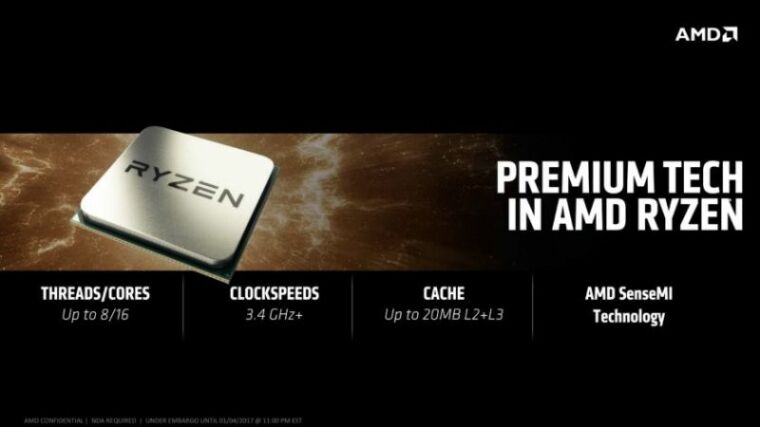AMD Ryzen news: latest CPU architecture from AMD fully takes on Intel's territory

AMD has given new information regarding the much-anticipated AMD processor dubbed the Ryzen during the recently held Consumer Electronics Show (CES) in Las Vegas. But one thing looks fairly certain, the company is coming down hard on rival Intel with various reiterations that it is not only here to compete but to eventually take over the market.
Arguably, there is still scarcity in terms of specifics of the Ryzen even after the CES event. Hence, the comparison will not be final until it is tried by users. But there are key pieces of information that AMD has straightforwardly confirmed to give potential buyers some motivation to check out the new chipsets. For starters, the eight-core, 16-thread processor is tipped to be faster and more efficient than its Intel counterpart. Multi-thread benchmarks that have been released so far claim that the Ryzen has a 10 percent advantage over the Core i7 6900K.
AMD's timing to rally its latest product cannot come at a more interesting time. Rival Intel has just released its brand-new mainstream quad-core Kaby Lake microprocessors and at this time, the set has been received with mixed opinions from those who were already able to sample it. The AMD Ryzen is poised to last for four years, as confirmed by Mark Papermaster, AMD's chief technology officer during the convention. Ironically this is the same the amount of time needed for it to be fully developed before being introduced to the public. And although the company exec declined to give any more specifics it has been reiterated that they are "not going tick-tock, Zen is going to be tock, tock, tock," referring to Intel's two-year tick-tock. Intel's cadence prompts them to develop a new microarchitecture every other year with Kaby Lake as the exception, given a bit of a stumble in the company's schematic scheduling.
No official release date has been announced but timeline-wise, the AMD Ryzen can be expected to drop in the middle or maybe even earlier in the first quarter instead of toward the end of the year. Industry people are betting that a February rollout is the most feasible in terms of pinpointing a month.
 Christians don't have to affirm transgenderism, but they can’t express that view at work: tribunal
Christians don't have to affirm transgenderism, but they can’t express that view at work: tribunal Archaeology discovery: Medieval Christian prayer beads found on Holy Island
Archaeology discovery: Medieval Christian prayer beads found on Holy Island Presbyterian Church in America votes to leave National Association of Evangelicals
Presbyterian Church in America votes to leave National Association of Evangelicals Over 50 killed in 'vile and satanic' attack at Nigerian church on Pentecost Sunday
Over 50 killed in 'vile and satanic' attack at Nigerian church on Pentecost Sunday Ukrainian Orthodox Church severs ties with Moscow over Patriarch Kirill's support for Putin's war
Ukrainian Orthodox Church severs ties with Moscow over Patriarch Kirill's support for Putin's war Islamic State kills 20 Nigerian Christians as revenge for US airstrike
Islamic State kills 20 Nigerian Christians as revenge for US airstrike Man who served 33 years in prison for murder leads inmates to Christ
Man who served 33 years in prison for murder leads inmates to Christ


 Nigerian student beaten to death, body burned over ‘blasphemous’ WhatsApp message
Nigerian student beaten to death, body burned over ‘blasphemous’ WhatsApp message 'A new low': World reacts after Hong Kong arrests 90-year-old Cardinal Joseph Zen
'A new low': World reacts after Hong Kong arrests 90-year-old Cardinal Joseph Zen Iran sentences Christian man to 10 years in prison for hosting house church worship gathering
Iran sentences Christian man to 10 years in prison for hosting house church worship gathering French Guyana: Pastor shot dead, church set on fire after meeting delegation of Evangelicals
French Guyana: Pastor shot dead, church set on fire after meeting delegation of Evangelicals ‘Talking Jesus’ report finds only 6% of UK adults identify as practicing Christians
‘Talking Jesus’ report finds only 6% of UK adults identify as practicing Christians Mission Eurasia ministry center blown up in Ukraine, hundreds of Bibles destroyed: 'God will provide'
Mission Eurasia ministry center blown up in Ukraine, hundreds of Bibles destroyed: 'God will provide' Church holds service for first time after ISIS desecrated it 8 years ago
Church holds service for first time after ISIS desecrated it 8 years ago Burger King apologizes for 'offensive campaign' using Jesus' words at the Last Supper
Burger King apologizes for 'offensive campaign' using Jesus' words at the Last Supper Uganda: Muslims abduct teacher, burn him inside mosque for praying in Christ’s name
Uganda: Muslims abduct teacher, burn him inside mosque for praying in Christ’s name